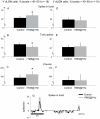Cortical modulation of the transient visual response at thalamic level: a TMS study
- PMID: 21347322
- PMCID: PMC3037393
- DOI: 10.1371/journal.pone.0017041
Cortical modulation of the transient visual response at thalamic level: a TMS study
Abstract
The transient visual response of feline dorsal lateral geniculate nucleus (dLGN) cells was studied under control conditions and during the application of repetitive transcranial magnetic stimulation at 1 Hz (rTMS@1Hz) on the primary visual cortex (V1). The results show that rTMS@1Hz modulates the firing mode of Y cells, inducing an increase in burst spikes and a decrease in tonic firing. On the other hand, rTMS@1Hz modifies the spatiotemporal characteristics of receptive fields of X cells, inducing a delay and a decrease of the peak response, and a change of the surround/center amplitude ratio of RF profiles. These results indicate that V1 controls the activity of the visual thalamus in a different way in the X and Y pathways, and that this feedback control is consistent with functional roles associated with each cell type.
Conflict of interest statement
Figures










Similar articles
-
Changes in visual responses in the feline dLGN: selective thalamic suppression induced by transcranial magnetic stimulation of V1.Cereb Cortex. 2007 Jun;17(6):1376-85. doi: 10.1093/cercor/bhl048. Epub 2006 Aug 14. Cereb Cortex. 2007. PMID: 16908494
-
A Comparison of Visual Response Properties in the Lateral Geniculate Nucleus and Primary Visual Cortex of Awake and Anesthetized Mice.J Neurosci. 2016 Nov 30;36(48):12144-12156. doi: 10.1523/JNEUROSCI.1741-16.2016. J Neurosci. 2016. PMID: 27903724 Free PMC article.
-
Spatial dynamics of receptive fields in cat primary visual cortex related to the temporal structure of thalamocortical feedforward activity. Experiments and models.Exp Brain Res. 2002 Jun;144(4):430-44. doi: 10.1007/s00221-002-1061-5. Epub 2002 Apr 13. Exp Brain Res. 2002. PMID: 12037629
-
Mapping the primate lateral geniculate nucleus: a review of experiments and methods.J Physiol Paris. 2014 Feb;108(1):3-10. doi: 10.1016/j.jphysparis.2013.10.001. Epub 2013 Nov 21. J Physiol Paris. 2014. PMID: 24270042 Free PMC article. Review.
-
Anatomical origins of the classical receptive field and modulatory surround field of single neurons in macaque visual cortical area V1.Prog Brain Res. 2002;136:373-88. doi: 10.1016/s0079-6123(02)36031-x. Prog Brain Res. 2002. PMID: 12143395 Review.
Cited by
-
Orexin A as a modulator of dorsal lateral geniculate neuronal activity: a comprehensive electrophysiological study on adult rats.Sci Rep. 2019 Nov 13;9(1):16729. doi: 10.1038/s41598-019-53012-9. Sci Rep. 2019. PMID: 31723155 Free PMC article.
References
-
- Kalil RE, Chase R. Corticofugal influence on activity of lateral geniculate neurons in the cat. J Neurophysiol. 1970;33:459–474. - PubMed
-
- Singer W. Control of thalamic transmission by corticofugal and ascending reticular pathways in the visual system. Physiol Rev. 1977;57:386–420. - PubMed
-
- Geisert EE, Langsetmo A, Spear PD. Influence of the cortico-geniculate pathway on response properties of cat lateral geniculate neurons. Brain Res. 1981;208:409–415. - PubMed
-
- Murphy PC, Sillito AM. Corticofugal feedback influences the generation of length tuning in the visual pathway. Nature. 1987;329:727–729. - PubMed
Publication types
MeSH terms
LinkOut - more resources
Full Text Sources

